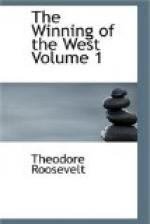65. Drayton; the “Am. Archives” say only twelve killed and twenty wounded. In another skirmish at Cheowee three South Carolinians were killed.
66. “Am. Archives,” 5th Series, II., p. 1235.
67. Do.
68. Do., p. 990; Drayton puts the total Cherokee loss at two hundred.
69. Do., Vol III., p. 33.
70. These two events took place on September 26th and 29th; “Am. Archives,” 5th Series, Vol. II., p. 540. Ramsey is thus wrong in saying no white was killed on this expedition.
71. McAfee MSS.; one of the McAfees went along and preserved a rough diary of dates.
72. “History of Virginia,” John Burke (continued by L. H. Girardin), Petersburg, 1816, p. 176.
73. After camping a few days at Double Springs, the head-waters of Lick Creek, to let all the Watauga men come up.
74. They sent spies in advance. The trail led through forests and marshy canebrakes; across Nolichucky, up Long Creek and down Dunplin Creek to the French Broad. Haywood and Ramsey.
75. McAfee MSS.
76. Nov. 5th. Do.
77. Nov. 8th. Do.
78. The boundary then established between the Cherokees and Watauga people was known as Brown’s Line.
79. As a very rough guess after a careful examination of all the authorities, it may be said that in this war somewhat less than two hundred Indians were slain, all warriors. The loss of the whites in war was probably no greater; but it included about as many more women and children. So that perhaps two or three times as many whites as Indians were killed, counting in every one.
CHAPTER XII.
GROWTH AND CIVIL ORGANIZATION OF KENTUCKY, 1776.
By the end of 1775 Kentucky had been occupied by those who were permanently to hold it. Stouthearted men, able to keep what they had grasped moved in, and took with them their wives and children. There was also of course a large shifting element, composing, indeed, the bulk of the population: hunters who came out for the season; “cabinners,” or men who merely came out to build a cabin and partially clear a spot of ground, so as to gain a right to it under the law; surveyors, and those adventurers always to be found in a new country, who are too restless, or too timid, or too irresolute to remain.
The men with families and the young men who intended to make permanent homes formed the heart of the community, the only part worth taking into account. There was a steady though thin stream of such immigrants, and they rapidly built up around them a life not very unlike that which they had left behind with their old homes. Even in 1776 there was marrying and giving in marriage, and children were born in Kentucky. The new-comers had to settle in forts, where the young men and maidens had many chances for courtship. They married early, and were as fruitful as they were hardy.[1] Most of these marriages were civil contracts, but some may have been solemnized by clergymen, for the commonwealth received from the outset occasional visits from ministers.




